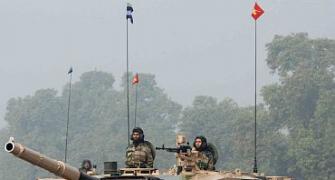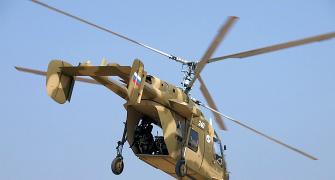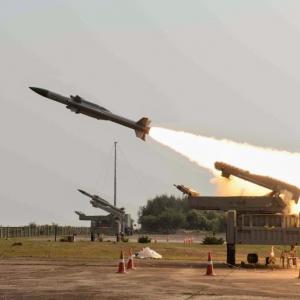The navy's plan to build three Russian Talwar-class frigates has a less than wholesome odour, says Ajai Shukla.

The Indian Navy, clearly, has an appetite for punishment.
One might imagine that the nightmarish experience of refurbishing the Gorshkov -- now the aircraft carrier, INS Vikramaditya -- in a Russian shipyard would be enough to forestall any more such warship building projects. But no!
Although the Gorshkov took more than twice the contracted time (118 months instead of 52 months) and almost thrice the contracted cost ($2.3 billion instead of $947 million), the navy now wants to involve itself in building three Russian Talwar-class frigates.
Frigates are versatile, multi-role warships of 4,000-6,000 tonnes that can deal with threats from the air (fighters and missiles), surface (missiles and guns) and underwater (submarines).
The navy is 61 vessels short of its planned strength of 198 warships and this shortfall is most keenly felt in capital warships like frigates, the business end of any navy, with their ability to operate independently in the face of multi-dimensional threats.
But there are capacity limitations to building more frigates in India: our yards that can do so are already stretched to capacity.
Mazagon Dock Limited, Mumbai and Garden Reach Shipbuilders & Engineers, Kolkata have orders for building seven Project-17A frigates in India.
So the navy has proposed that Yantar Shipyard, located in Kaliningrad, Russia, should tie up with an Indian private sector shipyard to build three Talwar-class frigates in India, to add to six such frigates procured from Russia earlier.
To be sure, the navy's experience with the Talwar-class (Russian name: Krivak-III; or Project 1135.6) has been more reassuring than building the Gorshkov.
The six Talwar-class warships were delivered at the price contracted and with less than a year of delay.
The first tranche of three frigates (INS Talwar, Trishul and Tabar) was contracted in 1997 for about one billion dollars and delivered between 2003-04.
The second tranche of three (INS Teg, Tarkash and Trikand) was contracted in 2006 and delivered in 2012-13 for a slightly higher price.
But the proposed third tranche has a less than wholesome odour, and not just because they are at least twice the cost.
In December, Russian President Vladimir Putin urged Prime Minister Narendra Modi to take three Talwar-class frigates off Russia's hands for three entirely self-serving reasons.
First, Yantar shipyard has six frigates languishing in various stages of build, but the Russian Navy wants just three.
Yantar began building six because Moscow was certain it could persuade perpetual-buyer India of the need for another three frigates.
Second, the frigates that languish in Yantar have no power plants (engines).
Ukraine has refused to supply Russia the Zoryagas turbines that power earlier Talwar-class frigates, and which were contracted for this batch too.
Ukraine's refusal comes after Moscow's military adventure in Ukraine and its annexation of the Crimea. Squeezing another power plant into the Talwar-class hulls would involve major re-engineering.
India, on the other hand, with strong defence ties with Ukraine, could obtain Zorya turbines without much problem.
Thirdly, even though Moscow's proposal has been cloaked in the rhetoric of "Make in India", the Talwar-class features mainly Russian systems, sensors and weapons, which cannot be changed without adversely impacting on delivery time lines.
To select an Indian partner shipyard, Yantar experts have toured, and approved, at least three Indian shipyards -- Larsen & Toubro's new Katupalli shipyard, near Ennore; Pipavav Shipyard in Gujarat, recently taken over by Anil Ambani's Reliance Infrastructure; and Cochin Shipyard Limited.
It is unclear whether the build plan involves transporting three partly built hulls from Russia to India and finishing the construction here; or whether it is planned to build three frigates in India, ground-up. Either way, the ghost of Gorshkov looms over this hare-brained project.
There is no convincing reason for New Delhi to contemplate a government-to-government proposal with Moscow, in which competitive tendering is abandoned, and a foreign design adopted, to build the Talwar class in India.
Instead, the navy, with its proud tradition of developing and building Indian-designed-and-built frigates, should insist on another three Project 17-A frigates, to add to the seven that are slated to start construction shortly.
Even the predecessors of Project 17-A -- the three 5,600-tonne Shivalik-class frigates built under Project 17 - are regarded as superior to the Talwar-class. Project 17-A will obviously be another notch ahead. Like the Shivalik-class, Project 17-A frigates would embark two medium helicopters, greatly enhancing their anti-submarine and airborne early warning capability. Much of the weaponry that will equip Project 17-A frigates is indigenously built, including rocket launchers, Brahmos cruise missiles and the world-class Long-Range Surface-to-Air Missile (LR-SAM). Vitally, the indigenous frigates would have secure Indian-designed electronic warfare (EW) systems and a tested indigenous "combat management system", the computer brain that controls the frigate's arsenal in battle. The levels of "Make in India" achievable in Project 17-A could never be matched whilst building the Talwar-class in India. Furthermore, adding another three frigates to the seven already being built under Project 17-A would enhance economies of scale, reducing per-unit price of the frigate. And, with the Directorate General of Naval Design having already finalised much of Project 17-A's design, build time would be greatly reduced, eroding one of the key arguments presented to justify buying the Talwar-class.
Instead of the bizarre solution of Russia deciding which Indian shipyard should build naval frigates, this should be decided through competitive tendering between Pipavav, L&T and other eligible Indian shipyards. The defence ministry must evaluate proposals, with greater indigenisation being a key parameter for selection, along with a company's track record and warship construction infrastructure. The contract should include exemplary penal clauses that impose stiff monetary penalties on delays and quality shortfalls, as well as cancellation of defence production licences for inordinate delays. The defence ministry must also promote scale manufacture by coordinating common sub-vendors for all three shipyards that would simultaneously build Project 17-A - MDL (four ships), GRSE (three ships) and the selected private shipyard (three ships). This would also be an opportunity for a comparative evaluation of three shipyards to deliver on time, on cost and as per quality standards.
There is no war looming that forces the defence ministry into the messy business of hybrid solutions - Russian hulls, Indian build, Russian fitments, sensors and weapons. If the ministry has a pressing compulsion, it is to demonstrate that it can, coherently and logically weave together the numerous threads of warship building into a strong fabric. Its decision on these three warships would be an important signal of intent.











